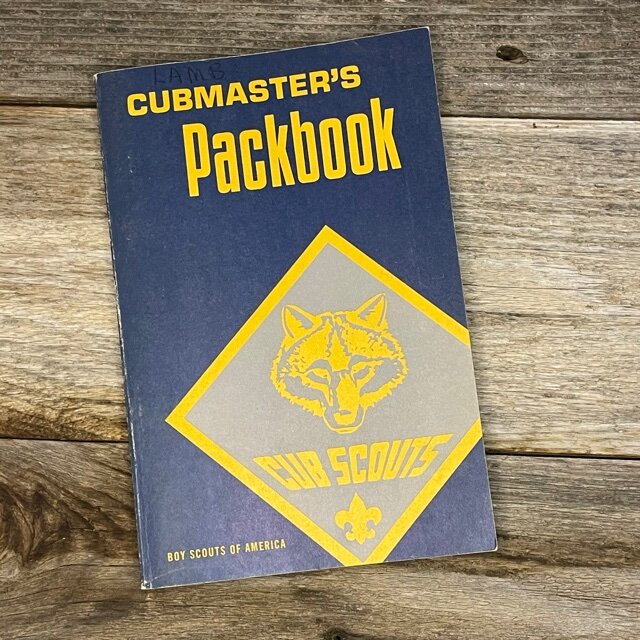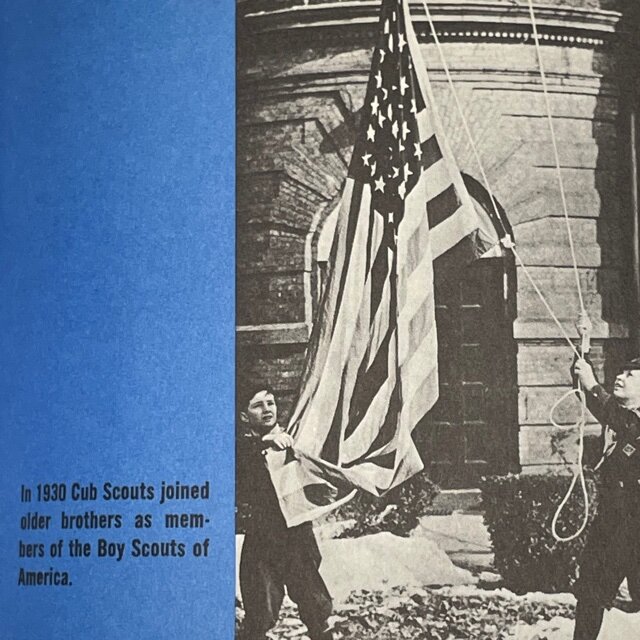Cub Scouting Background
Every now and then it’s fun to crack open some of the Scouting books from years past.
Found in the 1973 printing of the Cubmaster’s Packbook, we read on pages 192-195 about some background of how the Cub Scouting program started.
The Cub Scout program of the Boy Scouts of America was carefully built as a direct answer to the demands of millions of boys of Cub Scout age and their parents, who as early as 1911 were calling for their own program.
Wolf Cubbing started in England in 1914 when Baden-Powell began experimenting with a program for younger boys, based on Kipling's The Jungle Book. In 1916 he made a public announcement of this program, and since that time it has spread with very little change into the other European countries.
At the First National Training Conference of American Scout Executives in 1920, the needs of the young boys were emphasized, but the Boy Scouts of America felt it wise to defer action until there was more objective evidence. In 1925, Dr H.W. Hurt, a research psychologist, was authorized to study what was already being done in the way of a suitable program for younger boys and to explore general interest at various age levels. His recommendation indicated that boys 9, 10, and 11 responded even better to leadership and program efforts than older boys. ( At that time, boys had to be 12 to enter boy scouting.)
In 1926 the executive board authorized the Chief Scout Executive to proceed with a plan for raising $50,000 for a thorough scientific study of the whole younger boy matter. In 1927 an advisory committee was appointed, composed of top specialists in the fields of child psychology, family life, etc, to cooperate with the Boy Scouts of America in developing this program. At this time the Laura Spelman Rockefeller Foundation made available the $50,000 necessary to carry on the basic study, develop a plan, and produce the necessary literature.
In addition to the committee's already mentioned, advice was sought of various steps in the building of the program for more than 13,500 leading psychologists, sociologists, teachers, school superintendents, professors of education, college executives, and recreation and welfare directors.
The Executive Board approved a plan of experimenting in a limited number of communities, and on August 1st, 1929, the first demonstration units were started. In 1930 the Cub Scout program was formally launched with 5102 boys registered at the end of that year. During the next three years, close study of these experimental groups was made to determine the final development of a program. By 1933 it was felt the time had come to promote Cub Scouting as a part of the Boy Scouts program throughout the country, and the experimental restrictions were removed. In 1935 William C Wesel was appointed the first director of Cub Scouting.
For more than a decade the English Wolf Cub plan had been tried in America along with a score of other programs. Quite uniformly, these efforts failed because of the difficulty of keeping activities different from those of the Boy Scout troop, which took the edge off the boy’s later experience.
Our Cub Scout program corrected this. It is different from the younger boy program of any other country in the world because it is home and neighborhood centered and is built around between-meeting-time activities. The program suggests a wide range of attractive things for the Cub Scout and his den to do, with the encouragement of parents and neighbors. It suggests things that youngsters enjoy doing on their own when not under adult direction. These activities are particularly suited to the boy of Cub Scout age and must be kept quite different from those he will encounter at 11 years of age.
Cub scouting in our country has drawn up the dramatic lure and lore of the American Indian for program background. It's promise and law were drafted with the advice of educators who are specialists in dealing with boys of these ages. Many handicrafts were developed in recognition that Cub Scout age is an appropriate time to learn skills. Original creative efforts were stimulated. The aim is not technical skill but rather through exploratory efforts to help boys discover hobbies.
A system of electives was instituted to force practice and making decisions as well as to provide things of interest to boys with widely varying desires and abilities. Cub Scout outings final objective is, through which advancement planning program, to deliver a graduating Cub Scout, stimulated and prepared to participate in the Scout program.
The Laura Spelman Rockefeller Foundation and the Boy Scouts of America were determined that the Cub Scout program should meet the needs of the American family. The measure of their success may be found in the fact that Cub Scouting now enrolls over 2,476,000 Boys and 800,932 leaders.
Recently a national study of boys 8 to 10 years of age was conducted by the Survey Research Center of the Institute for Social Research at the University of Michigan. This study was conducted for the Boy Scouts of America and it, along with other studies, became the basis for the improved program for Cub Scouting released in the fall of 1967.
1973, Cubmaster’s Packbook, pg 192-195


